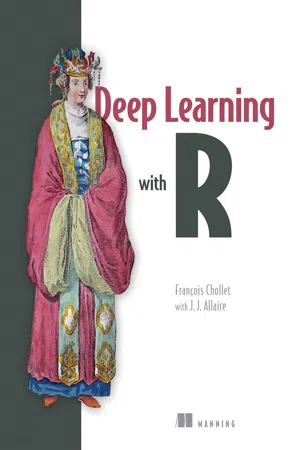
- 360 pages
- English
- ePUB (mobile friendly)
- Available on iOS & Android
Deep Learning with R
About this book
Summary Deep Learning with R introduces the world of deep learning using the powerful Keras library and its R language interface. The book builds your understanding of deep learning through intuitive explanations and practical examples. Continue your journey into the world of deep learning with Deep Learning with R in Motion, a practical, hands-on video course available exclusively at Manning.com (www.manning.com/livevideo/deep-?learning-with-r-in-motion).Purchase of the print book includes a free eBook in PDF, Kindle, and ePub formats from Manning Publications. About the Technology Machine learning has made remarkable progress in recent years. Deep-learning systems now enable previously impossible smart applications, revolutionizing image recognition and natural-language processing, and identifying complex patterns in data. The Keras deep-learning library provides data scientists and developers working in R a state-of-the-art toolset for tackling deep-learning tasks. About the Book Deep Learning with R introduces the world of deep learning using the powerful Keras library and its R language interface. Initially written for Python as Deep Learning with Python by Keras creator and Google AI researcher François Chollet and adapted for R by RStudio founder J. J. Allaire, this book builds your understanding of deep learning through intuitive explanations and practical examples. You'll practice your new skills with R-based applications in computer vision, natural-language processing, and generative models. What's Inside
- Deep learning from first principles
- Setting up your own deep-learning environment
- Image classification and generation
- Deep learning for text and sequences
About the Reader You'll need intermediate R programming skills. No previous experience with machine learning or deep learning is assumed. About the Authors François Chollet is a deep-learning researcher at Google and the author of the Keras library. J.J. Allaire is the founder of RStudio and the author of the R interfaces to TensorFlow and Keras. Table of Contents
PART 1 - FUNDAMENTALS OF DEEP LEARNING
- What is deep learning?
- Before we begin: the mathematical building blocks of neural networks
- Getting started with neural networks
- Fundamentals of machine learning
PART 2 - DEEP LEARNING IN PRACTICE
- Deep learning for computer vision
- Deep learning for text and sequences
- Advanced deep-learning best practices
- Generative deep learning
- Conclusions
Frequently asked questions
- Essential is ideal for learners and professionals who enjoy exploring a wide range of subjects. Access the Essential Library with 800,000+ trusted titles and best-sellers across business, personal growth, and the humanities. Includes unlimited reading time and Standard Read Aloud voice.
- Complete: Perfect for advanced learners and researchers needing full, unrestricted access. Unlock 1.4M+ books across hundreds of subjects, including academic and specialized titles. The Complete Plan also includes advanced features like Premium Read Aloud and Research Assistant.
Please note we cannot support devices running on iOS 13 and Android 7 or earlier. Learn more about using the app.
Information
Part 1. Fundamentals of deep learning
Chapter 1. What is deep learning?
- High-level definitions of fundamental concepts
- Timeline of the development of machine learning
- Key factors behind deep learning’s rising popularity and future potential
1.1. Artificial intelligence, machine learning, and deep learning
Figure 1.1. Artificial intelligence, machine learning, and deep learning

1.1.1. Artificial intelligence
1.1.2. Machine learning
1A. M. Turing, “Computing Machinery and Intelligence,” Mind 59, no. 236 (1950): 433-460.
Figure 1.2. Machine learning: a new programming paradigm

1.1.3. Learning representations from data
- Input data points—For instance, if the task is speech recognition, these data points could be sound files of people speaking. If the task is image tagging, they could be pictures.
- Examples of the expected output—In a speech-recognition task, these could be human-generated transcripts of sound files. In an image task, expected outputs could be tags such as “dog,” “cat,” and so on.
- A way to measure whether the algorithm is doing a good job—This is necessary in order to determine the distance between the algorithm’s current output and its expected output. The measurement is used as a feedback signal to adjust the way the algorithm works. This adjustment step is what we call learning.
Table of contents
- Copyright
- Brief Table of Contents
- Table of Contents
- Preface
- Acknowledgments
- About This Book
- About the Authors
- About the Cover
- Part 1. Fundamentals of deep learning
- Part 2. Deep learning in practice
- Appendix A. Installing Keras and its dependencies on Ubuntu
- Appendix B. Running RStudio Server on an EC2 GPU instance
- Index
- List of Figures
- List of Tables
- List of Listings